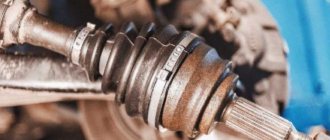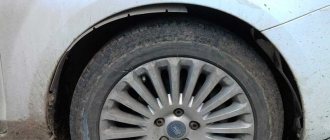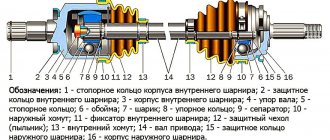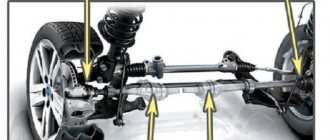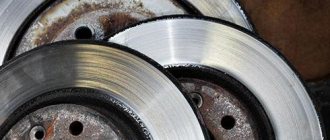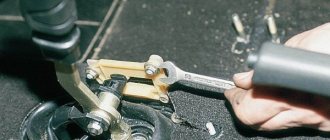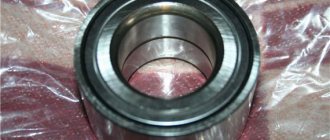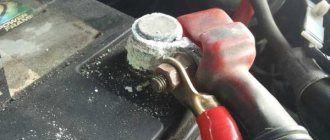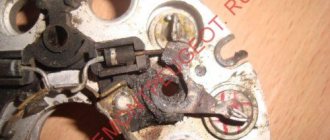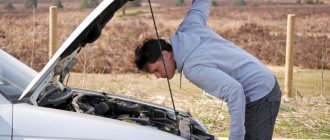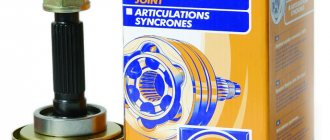Probably, many car enthusiasts have heard such a word as CV joint. When stopping at a service station, you can hear a lot of interesting words, but most drivers are afraid of a CV joint failure like fire. What kind of cunning device is this, and why its repair costs a pretty penny, we’ll find out in today’s article.
It is worth noting that literally fifty years ago, car enthusiasts had no idea about such an invention. CV joint is an abbreviation that stands for constant velocity joint. The principle of operation of the mechanism was used in Ancient Greece. Modern CV joints became widespread in the 50s of the last century.
What is a CV joint and why is it needed?
Location of external and internal CV joints
As a rule, in auto repair shops, professional craftsmen call the mechanism a “grenade”. All because of the appearance and complex design, vaguely reminiscent of a hand grenade. There is even a joke that every car has a “grenade” that will explode anyway.
CV joint (constant velocity joint) is a joint designed to transmit torque between shafts that are at an angle to each other. This is the main task. The design is installed on almost all modern cars. Without such a mechanism, it is impossible to transfer the momentum from the engine to the wheels, no matter the front or rear, without loss. It was with the advent of the CV joint that cars became more mobile and controllable.
CV joint solves many problems.
- Helps remove excess vibration.
- Synchronizes the rotation of the drive wheels.
- Reduces the load on the drive shaft while the vehicle is moving.
The transmission of motion is carried out at an angle between the front or rear axle shafts. The design is very useful, but if broken it can lead to expensive repairs. This is why many vehicle owners are even afraid to say the abbreviation out loud, so as not to cause trouble.
Why do you need a CV joint in a car?
Front-wheel drive and a transverse engine revolutionized the automotive industry. One can argue for a long time about the advantages and disadvantages of various drive schemes for drivers and roads, but from the point of view of manufacturers, this combination has become an absolute blessing:
- the layout of the car has gained additional freedom for the designer due to the precise localization of the power unit and transmission;
- a monoblock consisting of an engine, gearbox and drive gearbox with a differential is as compact as possible, has good rigidity and minimal weight;
- many problems associated with vibration loading of the transmission are eliminated;
- the body can have a flat floor, without a tunnel under the driveshaft to the rear axle;
- the absence of a drive rear axle gearbox and axle shafts allows the suspension to be packed more tightly, providing a voluminous and deep compartment for luggage;
- space for rear passengers has increased;
- fuel tanks began to increase in volume without damaging the trunk;
- additional space was freed up for the spare wheel, and in its absence the compartment could be used as an additional luggage organizer;
- the apparent stability of a front-wheel drive car on the road provided an excellent advertising effect, forever masking the true reasons for the emergence of mass front-wheel drive.
With so many influencing factors, solving the problem of transmitting torque to the steered wheels has become a matter of technology. At first, not very perfect, and then modern front-wheel drive articulated shafts began to appear.
The quality has increased and the price has decreased, as a result, similar designs are now used in rear-wheel drive, which allows for significant improvements in the rear suspension.
The design and principle of operation of the CV joint
Structure of external and internal CV joints: 1 - retaining ring of the inner joint housing;
2 — protective ring of the internal hinge; 3 — internal hinge body; 4 — shaft stop; 5 - retaining ring; 6 — clip; 7 - ball; 8 - thrust ring; 9 - separator; 10 - outer clamp; 11 — lock of the internal hinge; 12 — protective cover; 13 — internal clamp; 14 — wheel drive shaft (axle shaft); 15 — protective ring of the outer hinge; 16 — outer hinge housing. First of all, the hinge is designed to transmit driving force from the engine to the wheels of the car. The second important function is to maintain movement at different wheel planes. In simple words, when driving over a bump or hole, one of the wheels will be located higher than the second, while the movement of the car will remain unchanged. The complex design allows the wheels to move in different positions. The operating principle of each type of hinge is the same, only the design is different. The grenade can rotate at an angle of up to 70 degrees, while transmitting rotational motion to the wheels.
Instructions for replacing the CV joint with your own hands.
The first thing you need to do is make marks for the general location of the inner and outer races using a marker or scriber and then follow the instructions below, I also advise you to read the article replacing a VAZ CV joint.
- First you need to hold the hinge in a vice and turn out the inner part of the cage until it stops, remove the balls in pairs. In this case, you should help yourself with a screwdriver and tap with a hammer.
- After removing all the balls, proceed to install the separator, which is placed in a vertical position, and its windows should intersect with the end of the body.
- Next, remove the fist with the separator, rotating it and at the same time retracting one of the protrusions that are located in the separator window. After this work is done, you need to separate the specified parts.
- Now you need to look through all the parts and be sure to wash and dry them. If there are no chips, wear or discoloration in the areas, then the device can still serve for some time. But one of the defects on the parts was still discovered, which means they should be replaced with new ones.
The mechanism must be reassembled only in the reverse order, but before doing this, all parts must be lubricated. This assembly begins by inserting the inner race with the separator into the outer one (here you should not forget about the marks that were placed at the very beginning). The balls are placed in pairs. The hinge must be filled with lubricant, for example, “CV joint-4”, approximately 80 - 100 grams of the product per hinge. You can also use “litol” and other similar consistencies.
Remember, you shouldn’t skimp on them, since the performance of the CV joint largely depends on the amount of lubricant you apply to it. By the way, you still need to put it in a case, 40 - 50 grams. Next we knock out the hinge along the splines, put on the boot and tighten the clamp. This is the only way the boot will ensure a good seal on the joint. In addition, when lubricating, try to rotate the CV joint so that the lubricant is distributed evenly. Well, at the very end of the assembly, experts recommend checking whether there will be strong resistance during rotation. If everything is in order, then the CV joint replacement procedure was successful.
Types and types of "grenades"
Structurally, the CV joint may differ. It all depends on the manufacturer and type. There are currently four main types of grenades.
- Cam
- Tripoid
- Ball
- Cardan paired
The cam consists of two round elements, one of which fits into the other. This design allows the application of maximum axle loads. Typically, vehicles equipped with a cam joint only travel at moderate speeds.
Cam CV joint device
Tripoid consists of three bearings. Most cars are equipped with this system. It is more versatile and quite rigid, capable of working at high speeds and lasts quite a long time.
Operation of a tripod CV joint
The ball-type system operates on the principle of a tripoid system, only instead of rollers, the torque is transmitted by small metal balls enclosed in a shell and moving along specified channels.
Operation of a ball CV joint
The universal joint consists of conventional universal joints that transmit torque to the wheels of the car. Installed on large trucks.
Operation of the universal joint
Types of constant velocity joints
Ball variants of the CV joint design, although the most common in the passenger car industry, turned out to be not the only possible ones.
Ball joint
Tripod CV joints, in which rotating rollers with a spherical working surface play the role of balls, have found practical application for passenger cars and light commercial vehicles.
Tripod CV joint
For trucks, cam (cracker) joints of the “Tracta” type, consisting of two forks and two shaped disks, have become widespread. The forks in such designs are quite massive and can withstand heavy loads (which explains the area of their use).
Cam (suharikovy) CV joint
It is necessary to mention another option for CV joints - twin cardan shafts. In them, the uneven transmission of angular velocity of the first cardan is compensated by the second cardan.
Twin universal joint
As mentioned above, the angle between the axes of the two shafts should not exceed 20⁰ in this case (otherwise increased loads and vibrations will appear), which limits the scope of use of such a design mainly to construction and road equipment.
Inner and outer CV joints
In addition to differences in design, CV joints are divided according to the location of their installation into external and internal.
The inner CV joint connects the transmission to the axle shaft, and the outer CV joint connects the axle shaft to the wheel hub. Together with the drive shaft, both of these joints make up the drive of the car.
The most common type of external joint is a ball joint. The inner CV joint does not so much provide a large angle between the shafts as it compensates for the movements of the drive shaft as it moves relative to the suspension. Therefore, a tripod assembly is often used as an internal hinge in passenger cars.
A necessary condition for the normal operation of CV joints is lubrication of the moving parts of the hinge. The tightness of the working space in which the lubricant is located is ensured by anthers that prevent abrasive particles from entering the working surfaces. Taking into account the high load of parts, they use only types of lubricants specially developed for such components.
Malfunctions, signs and causes of breakdowns
Rupture of the CV joint boot
With normal driving and periodic checks, the joints can last for many years. From experience we can say that some CV joints work for 10-15 years without problems. The most common breakdown is wear of the boot. When the protective rubber breaks, dirt gets into the casing, the lubricant is washed out, and the system begins to malfunction.
In most cases, you can find out about a grenade failure while driving, as well as by ear. When dirt gets into the boot, the CV joint begins to make a specific noise when cornering. The sound is called "crunching". If you heard it once, it will be difficult to make a mistake. But it’s better not to hear it in your car! As a rule, a crunching noise signals the car owner about a lack of lubrication.
How does a CV joint (Grenade) work?
To understand how the CV joint (Grenade) works and how it works , you need to imagine a hinge joint. The most common design is a ball bearing consisting of:
- Housings;
- Separator;
- Clips;
- Sharikov.
Only, unlike a simple bearing, the race here is not flat, but three-dimensional. The balls in it move not only around the circle, but also in the transverse plane.
Advice for car owners
In order to avoid premature failure of the CV joint, it is recommended to periodically visit service stations and check the tightness of the outer protective casing. If there are any defects, it is better to replace the boot along with lubricant.
If the driver hears a characteristic crunching noise while turning, it is best to immediately contact a service station. The sooner the owner changes the boot and lubricants, the cheaper the repair will be. Undoubtedly, you can move around on a faulty “grenade” for a short period of time, but with great caution. The CV joint tends to get blocked in the direction of travel, it is better not to risk the lives of passengers and the driver!
It is worth noting that if you drive too aggressively, the mechanism fails much earlier than its lifespan. The service life can only be extended by safe driving and periodic checks of the condition of the boot.
In addition, I would like to say that not all car repair technicians can detect damage to the hinge by ear. There have been cases when a car owner, after listening to an unprofessional technician, bought an expensive part and ended up out of money, because the cause of the crunching noise could be other parts of the chassis. For example, a ball joint located on the front arms, if faulty, can make similar sounds when turning the wheel.
It is best to trust your car to trusted service stations with experienced technicians!
Debugg
The detection of even small defects in the boot indicates that the joint is filled with dirt and lack of lubrication. The CV joint cannot be operated in this condition, so it is necessary to remove the boot and fill the hinges with new lubricant.
Before applying fresh lubricant, the part is disassembled, thoroughly cleaned, and dirt is completely removed. Then the mechanism parts are washed with gasoline, dried and new lubricant is applied. For the internal hinge, 100–110 grams of lubricant are used; for the external hinge, 70–80 grams are sufficient. The CV joint is installed on the wheel and covered with a boot.
Experts recommend installing new, original boots after lubricating the hinge, since old parts lose elasticity and may crack after a short period of time. Non-original anthers do not fit perfectly at the mounting points, so a new portion of dust and water will quickly fill into the gaps.
You can fix the problem yourself
An important condition for the successful operation of CV joints is the choice of high-quality lubricant. Experts advise giving preference to compositions based on molybdenum disulfide, which minimize friction in the components and effectively protect them from corrosion, and also have a minimal destructive effect on the boot.
It is important! It is contraindicated to use graphite lubricant for CV joints. It cannot protect the part from increased loads, and therefore leads to accelerated wear.
What happens if you don't change the CV joint?
It is possible to operate a car with problems in the CV joint if a slight crunch is heard when turning: it is enough to replace the damaged boots and renew the lubrication of the part. When driving a car with a slightly damaged joint, you must reduce your speed when turning.
If vibration is observed when accelerating and a crunching sound is heard even when driving straight, the CV joint must be replaced urgently. A faulty CV joint can fail completely, causing the wheel to suddenly seize. If this happens at high speed, you can expect the most dire consequences.
It is important! On some vehicle models, significant wear or breakage of the tripod CV joint causes the bearing needles to be thrown into the gearbox housing, from where they are lifted along with the oil and ground by the gears. Repairing such an engine costs almost the same as buying a new car.
History of appearance
Early front-wheel drive cars, such as the Cord and Citroen TA, used double universal joints to transmit power to the drive wheels. The Weiss CV joints and cam structures, already known by that time, did not provide the required durability, and there were no special problems with space on large passenger cars. By the end of the 30s, the Weiss-type design and cam transmissions received real “registration” on a number of designs due to improved metalworking.
The achieved service life of 15–30 thousand km under load allowed vehicles with a plug-in front axle to have a total service life of the unit comparable to the service life of the vehicle, with acceptable dimensions and efficiency. The development of the design of front-wheel drive vehicles required new solutions - and the Hardy-Spicer company financed the creation Birfield hinges with high performance and reasonable cost. It was these joints that made the Austin Mini and other front-wheel drive BMC cars possible by 1959.
In Japan, on front-wheel drive Suzuki Suzulight cars in 1963, CV joints manufactured by NTN were used. By 1965, the design was optimized. Subaru cars introduced drive shafts that combined a Birfield-type joint with rigid axial fixation and a GKN-type joint with free movement. This solved the recent problems with vibrations and front suspension geometry of front-wheel drive cars, eliminating the need for complex drive shafts of a composite design.
The progress of car layout diagrams has made it possible to use CV joints instead of cardan joints in the rear axle drive. By the beginning of the 80s, an increase in the accuracy of CV joints and a decrease in backlash made it possible to use them instead of universal joints for shafts with high rotation speeds, such as a universal joint.
Don't think that progress has stopped. Thus, front-wheel drive cars with automatic transmission required the creation of low-noise CV joint designs with minimal backlash when rotating in both directions, since the CV joint of a classic design created unpleasant vibrations on a braked car. The problem emerged with the widespread use of front-wheel drive cars with automatic transmissions from the second half of the 70s.
Since 1998, eight-ball joints for passenger cars began to be introduced, which made it possible to reduce the size of the unit. Optimizing the shape of the grooves made it possible to improve the positioning accuracy of the balls, and therefore improve the efficiency and reduce the noise of the structure. New versions of hinges no longer receive company names as names - except perhaps letter type designations.
Optimization of tripod-type joints continues, primarily with the aim of reducing fluctuations in angular velocity during rotation and reducing noise. The working angle of the joints gradually increased compared to the original 43 degrees for NTN joints in 1963. By 1980, they received 44.5 degrees, and now ball joints of a shortened design already provide all 50 degrees of rotation, which significantly improves the performance characteristics of cars.
Even non-fixed GKN type hinges have significantly improved the working angles, from 23 degrees for the original patented design to 30.5 for modern versions. The growth in sales of crossovers and SUVs required the creation of drives with a large effective transmission angle, including modern shaft designs with two joints with shafts and a compensator fixed against longitudinal movement.
Transmission efficiency continues to increase, and the 99% efficiency achieved in the 1980s no longer seems ideal. Modern CV joints have more than half the losses.
How much do car grenades and drives cost and where is the best place to buy them, where to buy an internal grenade
One new external grenade costs about 1,700 rubles. Since internal grenades very rarely fail, it is almost impossible to buy them in a store. If the internal grenade has become unusable, then you should buy a contract drive assembly (as in the first photo, at Yukka Motors a drive with grenades costs about 2,000 rubles).
Replacing the drive, like one of the grenades, costs 600 rubles and takes about half an hour. When replacing the drive, the oil is drained from the box.
Contract drives last quite a long time; with quiet driving, they can last 2–3 years.
Rules for the safe operation of CV joints (Grenade)
The front wheel joint operates in difficult conditions - dirt, water and reagents fly from the road. The bearing housing is closed with a corrugated rubber coupling (boot). If the boot is damaged, dirt will get into the joint and begin to destroy the race, balls, and eventually the wheel will jam. If this happens at speed, the question of what a CV joint (Grenade) is in a car and how much it costs will be irrelevant, the body will be written off.
Therefore, if small tears or traces of grease appear on the corrugation, you should immediately contact service. come back
Why does the CV joint crunch?
While operating the car, the driver sometimes hears a faint crunching sound - the crunch of a grenade. This usually becomes noticeable when the wheels are turned to the maximum angle.
Why does the CV joint crunch? What to do in such a situation?
A crunch is evidence of a unit malfunction. Initially appearing only when the wheels are turned, later it begins to appear during straight-line movement. Extraneous sounds produced by the hinge require its replacement.
It’s easy to find out which CV joint is crunching. All you have to do is leave an assistant outside, unscrew the wheels and drive off slowly. The person remaining on the street will clearly hear where the sounds are coming from.
If you perform the diagnostics yourself, you should hang up the front wheels of the car and inspect the boots. Crisp grenades can be identified by their damage.
The fact is that the cause of the crunching is usually dust and grains of sand that get into the hinge through breaks in the rubber cap. Also, a malfunction can be suspected of a unit on which greater play was detected than on all other hinges.
